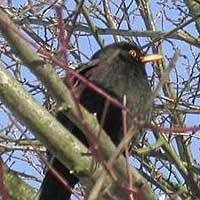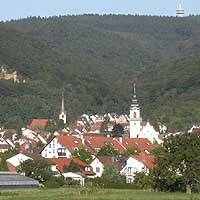I pass through the Heidelberg area of Baden-Buerttemberg in southwest Germany several times a year, and though I am transient there, I feel that I have roots -- roots that come from a natural connectedness with the earth. The several thousand hectares of land sandwiched between the gently rising hills of the Odenwald to the east and the Rhine to the west, and bounded by the fringes of the city to the south and the nameless sprawl to the north, are a primeval battleground where life moves in limited, reassuring cycles.
On this ancient landscape where the relentless forces of the land meet the untiring forces of the water, the tides of geographical warfare have drifted hither and thither. For long periods, the erosive powers at work on the hills have dribbled and drifted soils downslope, contributing to accretions along their western flank. The mighty Rhine, meanwhile, has writhed its way across this land for millennia, bucking, twisting and turning like a decapitated snake, depositing silts here, washing them away there, abandoning oxbow lakes that now lie still, glinting in sunlight, or glowering gray under the storm clouds that march up this, the widest of valleys imaginable.
Flowing out from the hills at Heidelberg is the Neckar, a substantial, broad river (though not when compared with the Rhine) that flows idly along, except when driven to violent surging by winter storms in the hills. The Neckar also contributes to the ceaseless land-water wars being fought here. A millennium from now, the wooded hills above the city of Heidelberg will no doubt appear much the same, but the confluence of these rivers will have shifted. Loads of silt deposited freshly today may, by then, have been reclaimed and cultivated, or built over; conversely, they may have been washed away along with the old, leaving the river plowing an altogether new furrow.
I walk here, not along shady woodland paths amid towering trees, as I do in my local forest in Hokkaido, but on farm roads and tracks between open fields and greenhouses. This is a completely utilized landscape; market-gardening crops, such as lettuce, radishes and strawberries, grow here each in their season. Its richly nutritious flatness is a growers' haven, and perfect for dog-walkers, joggers, roller-bladers and cyclists. Though the whole area is so heavily used, and may hardly seem a place to become attached to, it is the ceaseless, prominent circling of the seasons that provides the rootedness I feel.
Perceptions and experiences of nature do much to provide me with a sense of location, of stability, despite a peripatetic life of impermanence. The chill, loamy smell of the fields after winter rain; the crackling calls of winter thrushes; rooks cawing in the fields; the scent of apple blossom on the warming spring air as old fruiting trees (a reminder of the orchards that once covered this region) burst forth; the whistling of broad-winged buzzards as they soar over their territories; the thin cascading trills of serins singing from each treetop, and black redstarts wheezing their songs from each rooftop; the buzzing of bees drawn in summer to the towering sunflowers; the calls of migrant birds as they pass overhead in autumn; and the earthy smells of fungi and fallen leaves.
These and a multitude of other natural phenomena are what I call locators. They locate me as immediately in continental Europe, as the cascades of cherry blossoms, the "shreep" of bulbuls, the whirring of stag beetles or the whistling of sika (deer) tell me that I am in Japan. The natural biodiversity of a region, the specificity of the scents, sounds and sights of it all, combine to produce a precise set of references that define each locale naturally in as unique a way as the whorl on your finger identifies you. Every place has its own combination of natural locators -- you just need to tune in to them.
The majestic, moon-reflecting Rhine is a highway followed annually by birds that have reached central Germany after migrating from as far away as northern Scandinavia and sub-Saharan Africa. Rising air along its valley's escarpments provides the uplift that soaring birds prefer to use when moving long distances. White storks, for one, soar northward from Africa, crossing the foodless deserts of Africa and the salt waters of the Mediterranean before soaring ever northward up the Iberian Peninsula to reach their breeding sites on towers and steeples in semirural Germany. By this time of year, indeed, they are already there, reinforcing their huge, old nests of sticks, or building new ones.
If soaring is the easy way, then the hard way is flapping -- which is what the chiffchaffs do. These drab olive, undistinguished little insectivores first appear just before the spring leaf buds burst. The least of the summer songsters, it's hard to attach the word "musical" to their lightly sung, repetitive "chiff-chaff," or "tsiff-tsaff" -- but this simple song carries a powerful message for me.
What it tells me is a tale of the myriad tiny birds born in this area that headed off southward last autumn. It tells a tale of a trans-Saharan struggle, of a search for food, for water -- and of all those tiny, lifeless bundles of feathers so many become on the way south, with even more failing in their bid to journey way back north. By spring, when the chiffchaffs' songs resound once more from village and farmland tree tops, and warn of April showers from leafing hedgerows, it seems that it is as much a message of survival -- an insistent refrain of "I made it; I made it" -- as it is a sexual signal announcing "pick me; pick me."
A regular walk in the woods, or a stroll around a park or fields, is a marvelous way to find your own natural locators. Early mornings and evenings are best, when scents and sounds are strongest.





